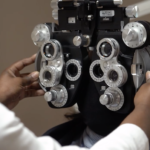
Dr. Aworunse examines a patient. She says it is worthwhile for both the patient and practice to spend time asking patients targeted questions in the exam room.
By Feyi Aworunse, OD, FAAO
Jan. 5, 2022
You have limited time with patients in your exam room. It’s important to make that time count by asking questions that will enable you to provide better care while also directing patients to products and services that would benefit them.
Here are three questions I ask in the exam room that positively impact patient care and my ability to prescribe additional services and products that will improve their lives.
“How do you typically spend your day?”
This question gives us a glimpse into the patient’s daily routine. It also opens the floor for them to share details about themselves and their interests.
Responses such as, “I’m in front of the computer all day,” “I work outdoors” or “I am around a lot of dust and debris” can tell us much about a patient’s work environment and the need for products like computer eyewear, sunwear or safety glasses.
Patients engaged in detailed near tasks during the day may require a different level of correction compared to those who do not. For example,I discuss the importance of visual hygiene to prevent digital eye strain with patients who spend much of their day using digital devices.
When it comes to ocular and visual health, patients are increasingly seeking ways to prevent harm or discomfort. Depending on the patient’s concerns or desires, there are innovative lens technologies that can optimize their vision. Many patients initiate a conversation about blue light protection because of their device usage. Patients who work in hazardous conditions are educated on the importance of protective eyewear to prevent injury and potential vision loss.
Limiting lifestyle questions to what a person does for work limits the conversation. We know that our vision and ocular health are not limited to our occupation or vocation. What if the patient volunteers rather than works, or what if they are unemployed? An out-of-work patient may be alienated by this question and cut off further communication.
For instance, if you never learn that the software engineer enjoys outdoor activities on the weekend, you might miss the opportunity to discuss product options like sunwear or polarized lenses in addition to products that optimize their vision at work.
Asking, “how do you spend your day?” Following up with, “how do you spend your free time?” And/or asking about hobbies can help guide the conversation beyond occupation.
By offering recommendations specific to the patient’s lifestyle needs, there is an increased chance of that patient following through with products targeted to them, and they may be more likely to return to your practice. An individualized patient experience can set your practice apart and increase patient loyalty, generating referrals from friends and family.
How do you feel about your vision (or the way you see)?
This question offers more insight into the quality of the patient’s vision and its potential impact on their quality of life and daily activities.
Patients may say, “my vision is fine” or “my vision could be better/my vision has gotten worse.”
I discuss the potential reasons their vision may have changed, giving special consideration to patients who may have developed cataracts or have a chronic disease that may negatively impact their vision.
If a patient tells me or the technician their vision is “fine,” I follow-up by asking, “Do you feel like your vision allows you to do everything you need or want to do?”
Some patients may not have any vision complaints, but desire an updated prescription to obtain new eyewear or contact lenses. This is an opportunity to discuss new ophthalmic or contact lens options with the patient.
Other Articles to Explore
If vision is not an issue, the patient may benefit from options that can enhance their current visual experience or improve efficiency while performing certain tasks. Photochromic lenses, polarized lenses, anti-reflective lens treatments and other lens technologies may be beneficial to the patient.
If a patient mentions their vision is great, but they feel hindered by their glasses during outdoor or physical activities, you have an opportunity to discuss the options for contact lenses, even if on a part-time basis.
Sometimes patients may not share concerns about their vision for various reasons. You may have a patient who says, “everything is fine,” but you note a decline in their vision. Some patients may feel pressure to “perform” or avoid stating anything that may indicate there is a problem with their vision.
Asking, “Have you noticed any change in your vision?” prompts a yes or no response, which might limit our opportunity to address patient concerns that go unstated.
Questions such as, “How do you feel about your vision?” Or, “Is there anything that you would like to do, or used to do, but now feel limited by your vision?” expands the conversation, allowing you to hear the patient’s vision concerns, in their own words.
The capture or conversion rate for purchasing eyewear among those who have a stable prescription (or no vision complaints) may be higher if this conversation takes place.
Patients may be more likely to consider specific lens technologies after proper education from the eyecare provider. Conversations like these empower the patient to make informed decisions about product purchases and, potentially, lessen the feeling of being overwhelmed by the optical experience.
How do your eyes feel throughout the day, week, since your last visit, etc.?
This question offers insight into the patient’s ocular health, from a comfort standpoint. Many times ocular discomfort can result in poor vision, so this question potentially allows us to address multiple concerns.
Typically, patients will respond with a description of symptoms such as “itchy,” “watering,” “tired,” “dry” or “feels like something is in my eye.” Patients may also complain of frequent headaches and ask if it could have something to do with their eyes and vision.
After following-up with questions about location, timing and frequency of symptoms, I discuss why their symptoms may be occurring. If a patient has attempted therapies for relief of their symptoms, we have a discussion of what they have tried, how often and if it was successful. After evaluating their ocular health, I follow-up with my findings and then offer the best therapies or treatments for their symptoms.
Over-the-counter therapies for dry eye and ocular allergies are usually the first and most accessible recommendations made for the patient. Due to the many OTC eye drops available to the consumer, a discussion of eye drop formulations (gel, liquid, lipid-based, preservative-free, etc) and the dosing schedule best suited for the patient is beneficial. If the patient presents with significant signs or symptoms, the recommendation for prescription ophthalmic medications is made. Referrals or follow-up for specialty services for dry eye management are also sometimes made.
Patients who complain of headaches or migraines without relief may benefit from lens options that address eye misalignment in addition to correcting refractive error.
Diagnosing a chronic condition such as dry eye could increase the number of office visits for a single patient (annually to an average of one office visit per quarter).
If you opt to sell ophthalmic products in your office that target dry eye management or lid hygiene, you could experience an increase in revenue generated from the sale of in-office products after having this conversation with patients.
Patients often do not know what symptoms are preventable or treatable. Our patients are the only ones who can tell us about their experience. Open-ended statements like, “Tell me more” and “Can you describe that for me?” allows us to obtain more qualitative information to aid in a diagnosis and make effective treatment recommendations. While some patients may tolerate their symptoms, or fail to bring them up, because “it’s not that bad,” we should still seize the opportunity to educate them on their options to improve their ocular comfort and visual experience.
Further discussion about symptoms may offer us insight into the patient’s lifestyle, work or living environment. The symptoms of dry eye, for example, can sometimes be addressed with lifestyle modifications. If a patient shares that they sleep with the ceiling fan on year-round or they enjoy gardening despite having seasonal allergies, we can offer more effective treatment recommendations for their lifestyle.
Listening to the patient’s ocular comfort concerns and educating them on their diagnosis and treatment regimen is key. Patients who are well informed and understand the benefit of the products recommended are more likely to adhere to their outlined treatment plan and keep appointments for follow-up visits in your office.
 Feyi Aworunse, OD, FAAO, practices at the Eye Clinic at Nashville General Hospital at Meharry. To contact her: feyi.aworunse@gmail.com
Feyi Aworunse, OD, FAAO, practices at the Eye Clinic at Nashville General Hospital at Meharry. To contact her: feyi.aworunse@gmail.com

























